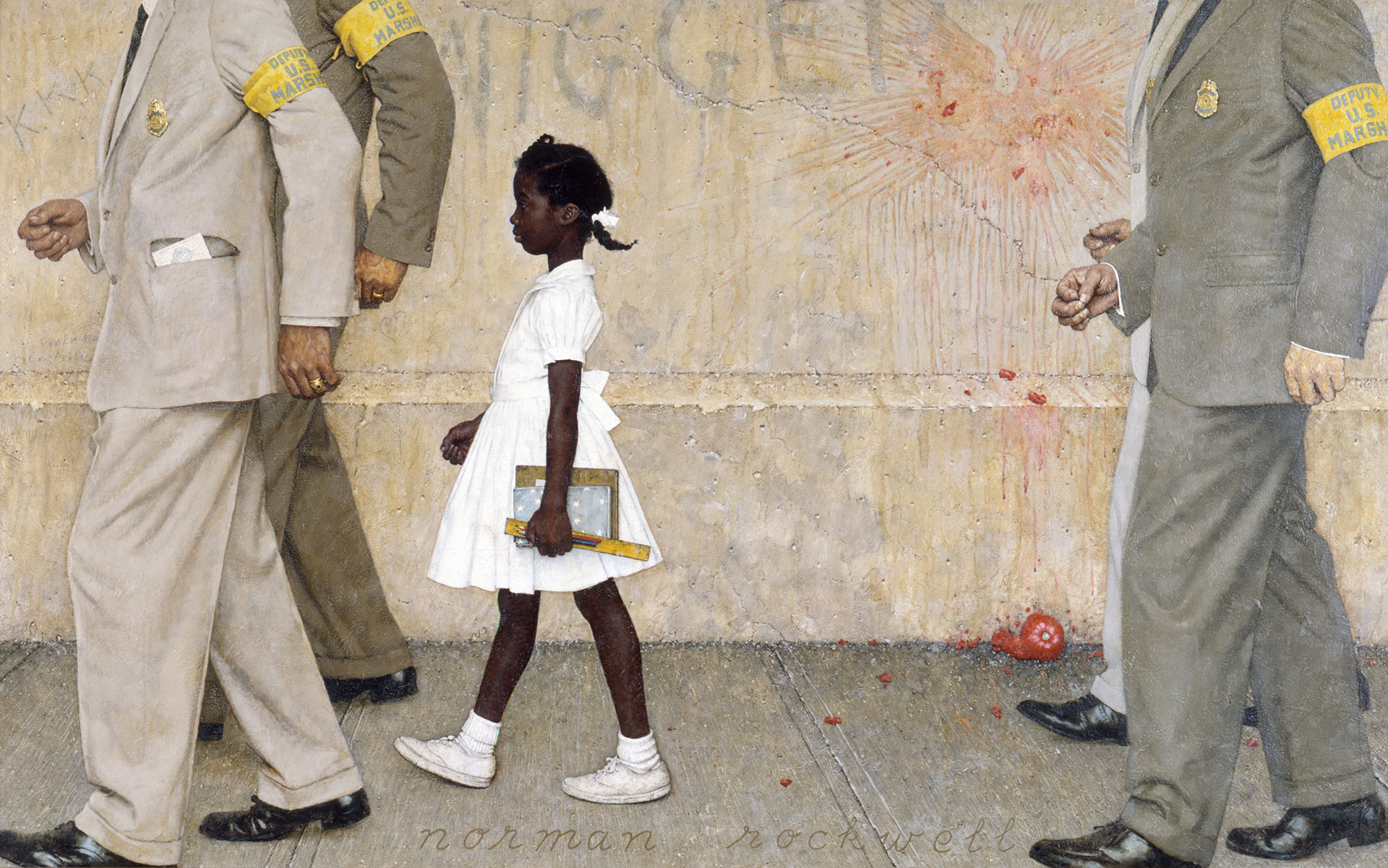Close Reading of The Problem We All Live With
Overview:
Students will examine the illustration, The Problem We All Live With, noticing the details within the context of the painting. They will look closely at the details within the painting, sharing these details. They will make supported inferences from these details, including Norman Rockwell’s purpose and message.
This activity will take one class period.
GRADE
9-12
THEME
Four Freedoms, Civil Rights
LENGTH
This activity will take one class period
Enduring Understandings/ Essential Questions:
- People were not always treated equally.
- People, young and old, help to bring about change in our country.
- We can learn about the history of our country not only from people who study the events that took place in the past, but also from people who participated in these events.
- Why are some people treated differently than others?
- In what ways can people help to bring about change?
- How do we learn about events that happened in the past?
- Are all accounts of a historical event the same?
Objectives:
- Students will closely examine Norman Rockwell’s painting, The Problem We All Live With.
- Students will make inferences related to the details and the title.
- Students will reflect on how some people were treated differently in the past.
- Students will participate in discussions about the illustration.
Background:
In the 1960s, particularly following the assassination of President John F. Kennedy in 1963 and the intensification of American military activity in Vietnam, long-held beliefs and cultural norms shifted dramatically in America. Attitudes about race, sexuality, and gender roles were challenged as diverse social groups united to fight for civil rights and protest the Vietnam War.
After resigning his forty-seven year tenure with The Saturday Evening Post in 1963, Norman Rockwell embraced the challenge of creating imagery that addressed the nation’s pressing concerns in a pared down, reportorial style. The Problem We All Live With for Look magazine is based upon an actual event, when six-year-old Ruby Bridges was escorted by U.S. Marshals to her first day at an all-white school. While the neutral title of the image invites interpretation, Rockwell’s depiction of the vulnerable but dignified girl clearly condemns the actions of those who protest her presence and the issue of desegregation. Letters to the editor were a mix of praise and criticism, but that did not stop Rockwell from pursuing his course.
In September 1960, years after the 1954 Brown v. Board of Education Supreme Court ruling stating that separate was not equal in America’s public schools, four African American students were selected to begin the integration process in the public elementary schools of New Orleans, Louisiana. One six year old, Ruby Bridges, was assigned to a first grade class at the William Franz Elementary School. The integration of the schools was not welcome by many white Americans in the south, and parents refused to have Ruby in their child’s class. As a result, she was the only student in the first grade class taught by Boston native, Barbara Henry. For many months, angry parents protested her attendance at the school.
Norman Rockwell’s painting, The Problem We All Live With, shows a young African American girl symbolizing Ruby Bridges being escorted to school by U.S. Marshalls despite the barrage of racial slurs and threats. The young girl who posed is Lynda Gunn, Rockwell’s neighbor in Stockbridge, Massachusetts, where he lived for his last twenty-five years.
Materials:
Multimedia Resources:
Classroom Supplies
- Chart paper with T-Chart labeled “What I See”/”What I think” (can infer)
- Marker
- Jim Crow Laws (These laws were enforced until 1965.)
Activities:
- Display the illustration of The Problem We All Live With.
- Ask students to look carefully at the illustration. Give them a few minutes to do this.
- Turn and Talk: When you feel enough time has passed, have students turn to a person sitting beside them. Ask them to share with each other some of the things they notice in the illustration. As they are sharing, listen in to their conversations.
- Have partners share some of the things they noticed in the picture. Record their responses on chart paper. (Elicit what was heard during partner talk that are not shared or share them for the students)
- Turn and Talk: When everyone has an opportunity to share, have students turn to face their partners again. Tell them to talk to their partner about what they are thinking based on the details they noticed.
- Have partners share their thoughts. Record responses on the T-chart. Elicit details from the picture to support their thinking.
- New observations may be contributed as they look closer and are thinking about the details. Add them to the appropriate column on T-Chart.
- If you have not already done so, share the origin of the painting and its name. Have students reflect on the purpose of the message that Mr. Rockwell would want them to understand, and what the message means to them.
- Optional Activity: Read Through Her Eyes by Ruby Bridges to the class.
Assessment:
- Did everyone participate?
- Are students basing their thinking on the details?
- Do student responses to the illustration reflect the relevance of personal interest and perspectives as well as civic virtues/principles which were in conflict during this movement?
- Do students’ responses reflect relevant thinking about the significance of the illustration in today’s world?
Standards:
This curriculum meets the standards listed below. Look for more details on these standards please visit: ELA and Math Standards, Social Studies Standards, Visual Arts Standards.



